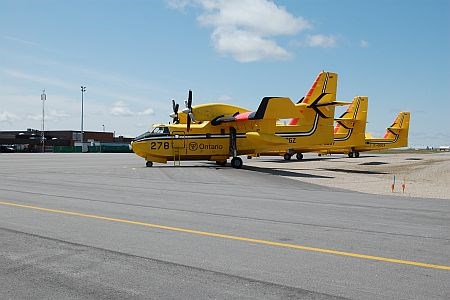If new business is coming over the horizon, Dryden airport manager George Friesen wants to be prepared.
This year, the bush was being peeled back southeast of the passenger terminal near the sprawling Ministry of Natural Resources (MNR) base to get a head start on the airport authority's future land use strategy.
The MNR and their forest fire management base is by far the airport's largest leased tenant. When the fire season gets rolling, the place turns into a tent city and modular home farm with as many as 50 helicopters parked near the flight line. For the airport, hosting that kind of traffic is big business in fees and fuel sales.
If and when the MNR makes good on its expansion plans, it could really open up a good case to attract some complimentary business opportunities. Local aviation company Hicks & Lawrence already provides fixed wing fire spotter planes for the ministry.
"We're taking the bull by the horns and clearing that area,” said Friesen. "This is a 20-year development plan and this is only year one."
The cleared land is being graded and new gas and phone line infrastructure upgrades will provide connections for a future business park lot development.
However, the airport authority and the City of Dryden are still wrestling with what to do with a 2,200-foot grass cross-wind runway.
As part of the airport's land-use plan there remain two options on the table.
Both involve an industrial park concept, but the intensity of development depends on whether the cross-wind – that partially bisects the 6,200-foot main runway – stays or goes.
The more intensive option provides space for medevac operations and existing tenants like Hicks & Lawrence, a future flight service station, space for hangars and air cargo possibilities to supply mining companies and remote First Nation communities.
As many as 16 hangars could be constructed in an aviation subdivision setting.
Friesen is also looking to pave a gravel taxiway that runs east and connects to the MNR complex and he wants to survey the taxiway northwest of the terminal for possible commercial aviation hangars.
“I believe in symmetry, it would give you a nice, neat hangar line all the way down (from the current passenger terminal to the MNR base).
Keeping the cross-wind runway would eliminate much of that. The local chamber of commerce wants to keep it for recreational pilot use.
Friesen favours the option that generates corporate investment and bases more planes in Dryden.
“We're playing toward our strength,” said Friesen. "Small airports generally are not necessarily in the business of doing business, but(are)in the business of allowing business to be done. So we have to make sure we have the infrastructure in place to go ahead."
Regardless of which option is chosen, it will likely bring with it a $15 million to $20 million price tag. That has to be approved by the city and will require federal-provincial infrastructure dollars.
“It's a 20-year plan and we're not expecting much right away. We're playing toward our strength.”
www.dryden.ca/city_services/dryden_regional_airport




